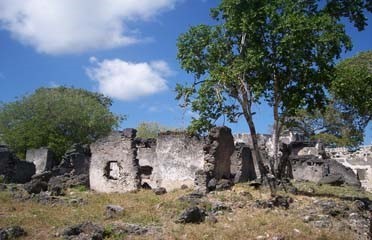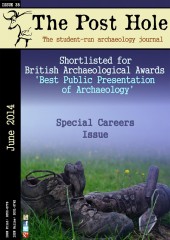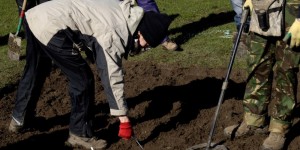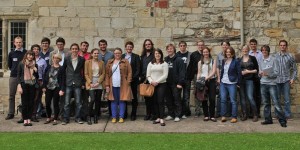Jeffrey Fleisher works in the Anthropology department at Rice University, Texas. His main area of interest is African archaeology and, alongside Stephanie Wynne-Jones of the University of York, he has directed three field seasons at Songo Mnara, Tanzania. He focuses on the archaeology of public and open spaces and non-elite people.
What area of archaeology do you work in?
I’m an African archaeologist, and have worked in eastern Africa for many years. Other than that, I don’t consider myself a part of a particular archaeological silo, but I suppose you could consider my work part of the archaeology of complex societies and/or urbanism.
What is your specialism?
I specialize in the archaeology of the Swahili, with a long-standing emphasis on the lives of rural and non-elite people. Recently, I have shifted my focus somewhat onto the archaeology of public and open space, but I see this as a part of my previous research with its emphasis on the more ephemeral parts of Swahili society. In terms of material culture, I have a great interest in ceramics, especially locally-made earthenwares.
How did you get involved in your current role?
My path to tenure-track position in the US was a bit lengthy, as I spent a number of years either teaching part-time or working in administrative positions. I worked for 5 years at Lehigh University, teaching in Anthropology and Africana Studies, but also working for the Provost’s Office. In those years, between the time when I finished by dissertation and when I took up my job at Rice, I continued to do field research and publish. I came to Rice in 2007, taking up my first tenure-track position.
What qualifications do you have and where did you study?
I completed all my degrees (BA, MA, PhD) at the University of Virginia in Charlottesville, Virginia, USA. While a graduate student there, I worked closely with Prof. Adria LaViolette, on her projects on Pemba Island, which is where I did my dissertation research. Dr LaViolette and I then co-directed a project together on Pemba, from 2002-06. Prior to working in eastern Africa, I worked extensively in the United States, in Virginia, New Mexico, and California on both research and contract projects.
Your area of interest is African archaeology. How did you become interested in this area?
Until 1993, I considered myself a historical archaeologist and planned to continue working in the US on colonial period sites. This changed when I, by chance, met Adria LaViolette and she invited me to work on one of her projects in 1993 on Pemba. That season was transformative for me, and I became intrigued by the Swahili coast, a place of cultural contact and rapid social transformation, and the global linkages evident in what were considered remote places. I returned to graduate school in 1995 in Virginia, focusing on rural-urban relationships on first and second millennium Pemba Island, Tanzania.
One of your current projects is at Songo Mnara in Tanzania along with Stephanie Wynne-Jones of the University of York. Could you tell us about this project and what your research aims are?
Dr Stephanie Wynne-Jones and I first considered work at Songo Mnara, a medieval Swahili site on the southern Tanzanian coast, while she and I worked on a ceramics project together in eastern Africa in 2008. We secured some seed funding from Rice, I organized a field school, and we ran a preliminary season there in 2009. This season was so incredibly productive, partially because the site is so amazing, but also because we were able to recruit an amazing team of archaeologists including Dr Kate Welham (geophysics, Bournemouth), Dr Federica Sulas (geoarchaeology) and Dr Sarah Walshaw (archaeobotany, Simon Frasier University) (to access Dr Sarah Walshaw’s interview follow https://www.theposthole.org/read/article/269). That season convinced us that the site had much to offer to address questions we had about the nature of public and private space in the Swahili world. We then applied for a joint AHRC/National Science Foundation grant and were lucky to be awarded it in 2011. We have now completed two seasons of that three-season project. We have been addressing our research questions through test and large-scale excavations in houses and in open spaces; this data is allowing us to begin thinking about how people were using public and private space, and how activities were structured within the town itself. We have been extremely fortunate that many houses contain significant floor deposits, and that the combination of geophysics, geoarchaeology, and archaeology, has allowed us to reconstruct activities across the open areas of the site.
When working with British colleagues, have you noticed a difference in the way American and British archaeologists work?
Not as many as you might expect. When Stephanie and I began working together, we talked extensively about how we would organize our project and, to be honest, there wasn’t much difference between our approaches. One major difference is the recording systems that we each used prior to the Songo Mnara project. We ultimately settled on a British one (MoLAS), a single context recording system. After the first season, I realized that although the systems may look different, they actually end up capturing the same data. I did have to learn about ‘cuts’, however! Besides this, the only major sticking points are the (unwarranted) disdain for Marshalltown trowels, and deep confusion over wearing khaki pants.
Working in Tanzania and the Swahili Coast, you must spend a lot of time travelling. How do you balance this with your daily life?
This is true. When I was younger, I would never turn up a chance to work abroad, and clocked many months of field work in sub-Saharan Africa. However, once you have a family and obligations with a university position, it becomes more challenging to balance fieldwork and home life. In general, I think it’s ultimately difficult to strike a balance, but you try your best. I generally try to stagger my longer field seasons now to every other year, which helps in some ways.
What is your favourite part of working on an excavation project?
There are so many great aspects of running a field project. The most exciting, for me, is to see how the extensive planning and preparation takes shape as the fieldwork unfolds. This is something that I think may be lost on students who work on field projects. But for the directors of a project, the field work is the culmination of an extremely long process of thinking, writing, and planning. And, with archaeology, there are always surprises to be had through field work. At Songo Mnara, the great joy has been the amazing integrity of the deposits and the way we have been able to reveal 15th-century contexts with such clarity. I also feel fortunate to work with so many other great archaeologists who make the field work really enjoyable.
Have you got any future projects lined up that you could tell us about?
I am currently in the preliminary stages of a new project in Zambia, south central Africa. This is a project that grows out of some writing I’ve done with Dr Kathryn de Luna, a Georgetown University historian, who uses historical linguistics to write about south central Africa’s precolonial past. We have had many discussions over the years about how to work collaboratively between archaeology and historical linguistics and we are attempting to put some of the ideas we’ve had into practice in Zambia. The project uses archaeological, linguistic and bioarchaeological data to investigate the social dimensions of mobility, including subsistence factors, political dynamics, and trade. This is a collaborative project that also includes Prof. Susan McIntosh and Dr Matthew Pawlowicz (to access Dr Matthew Pawlowicz’s follow https://www.theposthole.org/read/article/259).
Any tips for students reading this interview wanting to work in the same kind of role?
Get involved, get field and laboratory experience, and take every opportunity you can to get to practice the craft of archaeology. The other important thing is to find a region and topic that you love – this may mean branching out from the offerings in your undergraduate department, but it will be worth it. And be nice to people.
For further information on Jeffrey visit https://anthropology.rice.edu/Content.aspx?id=88 and to view some of his work follow http://rice.academia.edu/JeffreyFleisher








